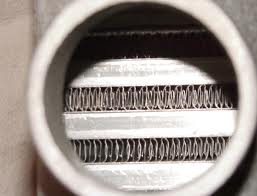| What's Hot! | Products/ Tools | EFI Tuning | Basic Tuning | Advanced Tuning | Chassis Tuning | Advertise with us |
Discussing the Density Of fins on intercoolers

Are all intercoolers equivalent?
Contributed by: Enginebasics.com
With the growth of Chinese made aftermarket parts, quality of parts has been a huge discussion. The goal of this article is to focus on how intercoolers can perform very different even though they are the same dimensionally.
When looking to buy an intercooler most people focus on finding one that can fit. While one could argue that this is the most important part, it’s what comes after that process that can be equally important.
So you have found an intercooler that fits, now what? Well it’s now going to come down to efficiency. One of the main things that affect the efficiency of an intercooler, and the topic of this article, is fin density. Not all intercoolers are made equal. If you take a close look at intercoolers you will see that some have much smaller fins than others. The smaller the fins are, the thinner the fins are, and the smaller they are the more you can put in a given area making the fin density higher, and the more heat you can potentially pull out of the hot air that is flowing through it.
(Click image to see full size)
The goal of an Air to Air or Water to Air intercooler is to act as a air heat exchanger. Those small fins, because of there small mass, can absorb and unload heat easily. Therefore the more small fins you have, the more heat you can absorb off the air passing through the intercooler on the way to your motor. The more heat you absorb, the more power your engine will make due to that air charge being cooler and denser. ALSO, the smaller fins not only absorb that heat better, they also release that heat more efficiently with the outside air coming in the front of your cars air dam and through the intercooler.
To summarize, you’re looking for an intercooler that has lots of small very dense fins. The smaller and denser the area of exchange has for fins, the more efficient your air to air intercooler will be at heat exchange.
So what do we learn? Not all intercoolers are the same. Next time your out at a car show or local parts shop, take a look at a nice intercooler core like those offered from Garrett or Precision, and compare them to others. TRUST ME, you’ll see the difference.
If your about to start a turbo project take a hard look at these universal intercoolers. Click on the photo's to see a larger image and details:
ATTENTION READER:
If you enjoyed the information and article you just read be sure to check out our newly released book with even more exciting photo's and information:How to Turbocharge and Tune your Engine

Want to know more about your particular Make and Model vehicle? All of these vehicles are covered in the tech, maintenance and repair articles found above. Enginebasics is the wiki or wikipedia of car part, repair, how to and tuning information. Let us be the class 101 for your automotive learning.
| Ford | General Motors GM | Pontiac | Jaguar | Land Rover | Nissan |
| Toyota | Honda | Lexus | Acura | Lotus | Scion |
| Infinity | BMW | Mercedes | Mitsubishi | Ferrari | Maserati |
| Lamborghini | Volks Wagen VW | Saab | Audi | Hyundai | Kia |
| Subaru | Mazda | Chevy | Volvo | Caddilac | Dodge |
| Chrylser | Daewoo | Porsche | Mercury | Freightliner | MG |
Individual Models
| Ford Mustang | Mitsubishi Eclipse | Mitsubishi Evo | Subaru WRX / STI | Dodge Viper | Chevrolet Corvette |
| Nissan Skyline | Honda S2000 | Nissan 350z | Toyota Supra | Chevy Camaro | Lotus Elise Exige |
| Honda Civic | VW Golf | Dodge SRT-4 | Eagle Talon | Acura Integra | BMW M3 |
| Nissan 240sx | Porsche 911 | Acura NSX | Honda Accord | Toyota Camry | Toyota MR2 |
| VW R32 | Dodge Truck | Mazda Rx7 | VW Jetta | Sand Buggy | Nissan Sentra |
For the latest Automotive news and stories visit the websites below |
Our feature Build: An AWD V6 Civic






